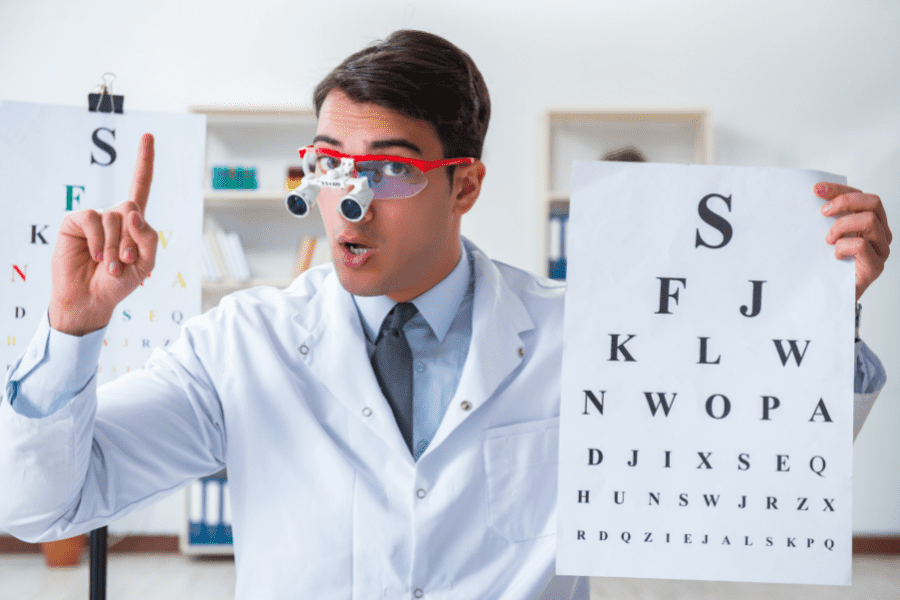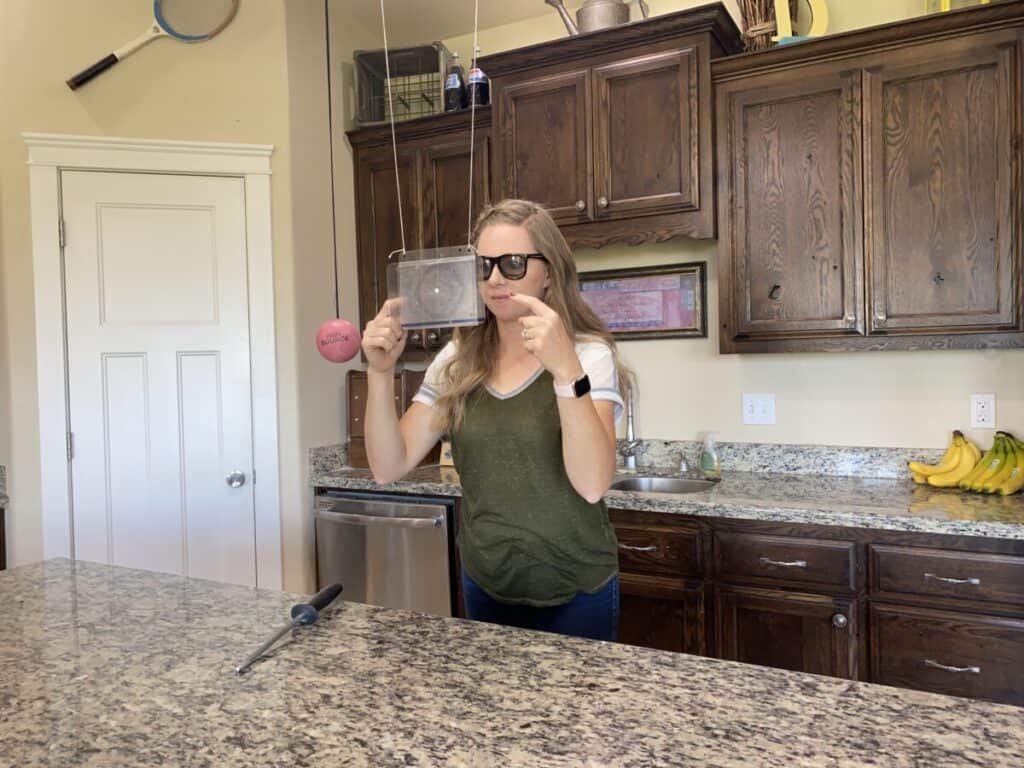As someone who has spent YEARS of her life patching, I can safely say that patching is the worst. Is it effective? Yes, depending on the diagnosis. But it is such a hassle. As an adult, I searched for a solution that didn’t include a sticky patch and here is what I have found.

There is a type of contact called an “occluder lens” that is essentially a black contact. They also have versions that simply blur vision. Putting this contact over the strong eye forces the weak eye to work and become stronger, without the unattractive and annoying bother of using an eye patch.
There are risks involved and the efficacy definitely depends on your diagnosis so checking with an optometrist to see if you would be a good fit is a great start.
To find an optometrist who is specialized in treating amblyopia (lazy eye) and strabismus (eye turn) fill out this form and I will do the research and send you options close to you!
For more about pro-cons and how to get an occluding contact lens, read on.
Why Choose a Contact Over Patching?
I will give you both vain and practical reasons for using an occluding contact rather than patching.
- A contact does not rip off eyebrows, eyelashes and skin.
- Patches draw tons of unwanted attention, the contact is much less noticable
- A contact does not ruin eye make-up (yes I know I am vain)
- A contact does not ruin hair (patches on a string really cramp my style)
- Contacts are more difficult to remove than a patch so “cheating” during patch time isn’t as likely
- Patches are unattractive unless you are under age 8, at which point they are the cutest ever.
Besides making it harder to cheat during patch time, using a contact isn’t going to really be any more/less effective. It mostly makes life easier and takes away the big issues many people have with patching. That could improve compliance which would be a big difference.
What Are the Risks Of Using an Occluding Contact Lens Instead of Patching?
While patching can help strengthen an amblyopic or “lazy” eye, if overdone it can reduce the ability of the eyes to work together.
If you have a 4 year old that has been prescribed patching for 2-3 hours each day, you will probably not forget to take the patch off. They will be pulling it off and you will be working to get to that 3 hour mark.
But if there is a contact in, it is much less noticeable and obtrusive so it could be forgotten and inadvertently left in all day. This could really damage binocular vision function. Patching can help strengthen a weak eye, but more and more research is showing that getting both eyes to work together with MFBF exercises (example here) is even more important than patching. It would be detrimental if the eye was patched or occluded too long.
Using a contact is more difficult with young children if they aren’t able to put it in and take it out or if they fight having you help them (although they probably prefer it to patching!). There are some great resources to help parents with this. Eye Power Kids has a great tutorial on getting a contact lens in for a young child.

An occluding contact lens can also be tricky for school aged kids who patch for part of the school day. Removing a contact at school just seems like a recipe for disaster…are they going to forget, loose the extremely pricey lens, infect their eye with mystery school germs, etc.
If you suddenly want to use both eyes, it isn’t easy to remove the contact and put it back in, it feels more permanent which can be great for a young kid, but annoying for an adult.
There are definitely ways to overcome these obstacles, set alarms, enlist the help of a school nurse, plan, and keep practicing, but it is good to see why some people choose to use a more simple eye patch.
The contact lens makes more sense for children who are with a parent during the patch time, those who are patching for extended periods of time, or adults.
*Note: I am not a big fan of long term and long time patching and think there are more effective ways to treat amblyopia. But if you are someone looking to patch for various reasons, an occluding contact lens may be a good option.
What Kind of Eye Doctor Will Prescribe an Occluding Contact Lens Instead of Patching?
Most optometry offices do not carry this type of speciality contact lens. It must be special ordered, but any optometrist has the ability to special order it. Some may suggest using a contact that blurs the vision instead of completely blocking it depending on your evaluation.
Exciting research is being done and contacts like the scotogenic contact lens (see article) blocks the central vision for the strong eye, but not peripheral which solves one of the major drawbacks of patching.
There are many doctors that have special training in fitting contact lenses and those offices will be better equipped to help you get the right contact. Usually that information can be found on their website so a quick google search “specialty contacts in ______(your city)” should yield good results.
I briefly interrupt your education with a little entertainment. Presenting the best stock photo optometrist model. I can’t stop laughing at his hilarious facial expressions! One can only hope for an optometrist with this much personality. Luckily, personality or not, they can still help you get the right contact lens.



They aren’t likely to suggest this treatment, so you will need to bring it up yourself. Most typical optometrists will simply ask you or your child to were a sticker patch or a cloth patch. Some use atropine drops, but I’ve not heard of using an occluding contact lens so it’s something you’d need to mention.
Is Patching the Best Treatment for Amblyopia?
Imagine that when you were born you couldn’t walk and because of this your parents decided to just brace your left leg in a bent position so you eventually learned to walk using your right leg and crutches (yes this is a huge stretch and would be totally abusive, but just hear me out).
Then, one day, you decided that you wanted to use both legs to walk.
After years of non-use, the left leg would be physically weak, uncoordinated, and your brain wouldn’t really know how to use it.
If you went into physical therapy their prescribed treatment would not simply be to isolate the weak leg and make it work. Would this be part of the treatment, absolutely! That leg would need to gain muscle tone and coordination and specified exercises for that leg would be important. But simply having two strong legs is not going to be beneficial if you never learned to walk.
The most important part would be learning to use the legs together. To coordinate walking, running, skipping, and stair stepping. As the brain learned to use both legs, the weaker left leg would become stronger and more able as they worked together.
Do you see the connection?
Patching is the equivalent of strengthening a weak leg, but not learning to walk.
It can strengthen a weak eye, but the source of the problem is that the eyes are not working together. Getting the eyes working together and exercising that skill will strengthen the amblyopic eye and help prevent the original problem.
Dr. Dan L. Fortenbacher FCOVD said:
“While the research shows that a child’s visual brain will show improvement in their amblyopic eye sight with a patching regimen, this “old school” approach (when used alone) can be very difficult and disruptive for the developing child to handle…Furthermore, unilateral patching therapy only teaches a patient how to be a “one eyed person” since it does not address the underlying cause for the amblyopia which is the lack of binocular (two-eyed) vision development.
Therefore today’s “best practices” approach for the treatment of amblyopia involves a combination of monocular and binocular training of the visual brain through office-based vision therapy.” (Source)

So yes, patching can make a difference, but it is only part of the solution. The eyes need to be taught to work together and that is where vision therapy comes in. An occluding contact lens can still be helpful, but just know it won’t be the whole solution.
If you would like help finding a vision therapy office, fill out this form and I will do the research and send you options close to you!
I also offer consultations where we meet over zoom and discus your options in detail. I do in-depth research on your geographical area on surgeons and vision therapy offices.
Good luck on your journey to amazing vision!
